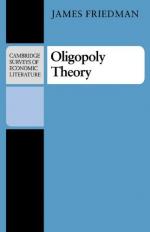|
This section contains 1,182 words (approx. 4 pages at 300 words per page) |

|
An oligopoly is an intermediate market structure between the extremes of perfect competition and monopoly. Oligopoly firms might compete (noncooperative oligopoly) or cooperate (cooperative oligopoly) in the marketplace. Whereas firms in an oligopoly are price makers, their control over the price is determined by the level of coordination among them. The distinguishing characteristic of an oligopoly is that there are a few mutually interdependent firms that produce either identical products (homogeneous oligopoly) or heterogeneous products (differentiated oligopoly).
Mutual interdependence means that firms realize the effects of their actions on rivals and the reactions such actions are likely to elicit. For instance, a mutually interdependent firm realizes that its price drops are more likely to be matched by rivals than its price increases. This implies that an oligopolist, especially in the case of a homogeneous oligopoly, will try to maintain current prices, since price changes in either direction can...
|
This section contains 1,182 words (approx. 4 pages at 300 words per page) |

|


